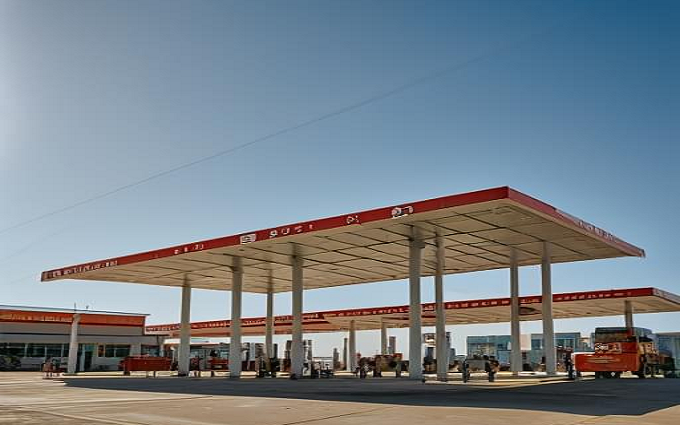Efficient Canopy Structures: Enhancing Gas Station Functionality and Aesthetics
The canopy truss at gas stations is a commonly used structural form in gas station buildings, characterized by the following features:

1. Large Span and Open Space: Truss structures provide a spacious canopy, offering ample room for vehicle movement and operations at the gas station.
2. Lightweight Structure: Compared to traditional building structures, truss structures are lighter in weight, reducing the overall weight of the building and lessening the load on the foundation.
3. Aesthetics: Truss structures can be designed in various shapes and styles, making the gas station more visually appealing and enhancing its commercial attractiveness.
4. Good Lighting and Ventilation: The open nature of trusses allows ample natural light to enter and aids in air circulation, improving the environmental quality inside the gas station.
5. Fast Construction: Most truss components can be prefabricated in the factory, making on-site installation relatively simple and shortening the construction period, thereby minimizing the impact on gas station operations.
6. Economical: Truss structures are relatively low in cost and highly efficient in use, reducing the construction and maintenance costs of gas stations.
7. Flexibility and Expandability: Truss structures are easy to modify and expand later, allowing adjustments based on the business development needs of the gas station.
8. Corrosion Resistance: Materials usually treated for corrosion resistance are used, giving the truss good durability to withstand the special environment of gas stations.
When designing and constructing gas station trusses, the following factors should be considered:
1. Scale and Layout of the Gas Station: Determine the size and shape of the truss based on vehicle flow, number of fueling islands, etc.
2. Wind and Earthquake Resistance: Consider local climate and geological conditions to ensure the truss's safety during severe weather and natural disasters.
3. Fire Protection Requirements: Implement appropriate fire protection measures, such as using fire-resistant coatings and installing fire-fighting equipment, to meet the safety standards of gas stations.
4. Lighting and Lighting Facilities: Arrange lighting fixtures reasonably to provide sufficient illumination for safe and convenient nighttime fueling operations.
5. Drainage System: Design a proper drainage system to prevent water accumulation and leakage.
6. Material Selection and Quality Control: Use standard-compliant steel and other materials to ensure the quality and durability of the truss.
7. Construction Quality and Supervision: Strictly control the construction process to ensure the installation quality and precision of the truss.
Gas station trusses provide a sturdy, aesthetically pleasing, and practical canopy structure that meets the functional needs of gas stations while enhancing their overall image. During design and construction, factors such as safety, environmental protection, and economy should be fully considered to build gas station trusses that meet the required standards.
RELATED NEWS
- Gas Station Construction Budget: How Much Does It Cost to Build a Gas Station? 2024-07-04
- Eight Key Factors in Aluminum-Magnesium-Manganese Roof Design 2024-07-04
- What Are Roof Purlins? What Are the Principles of Roof Purlin Layout? 2024-07-03
- Characteristics of Hangar Tents 2024-07-03
- How is the Shougang Ski Jump Both Sturdy and Light? 2024-07-02
Categories
Latest News
Contact Us
Contact: Mr.Lu
Phone: +86-51668601029
E-mail: hbktech@163.com
Whatsapp:86+15152106218
Add: 1412, Building 2, Vanke Huaihai Xintiandi, Block 3, Quanshan District, Xuzhou City, Jiangsu Province
